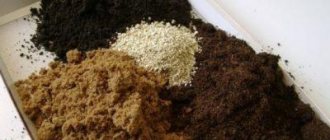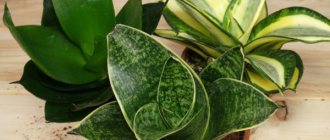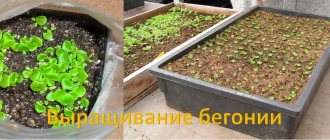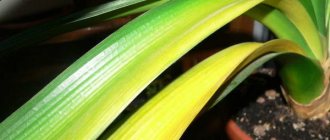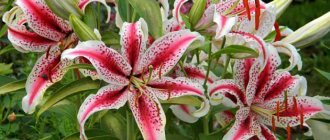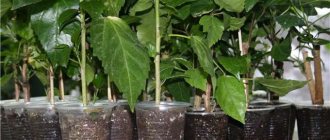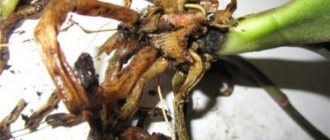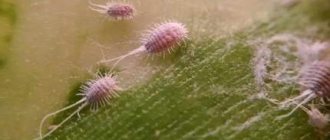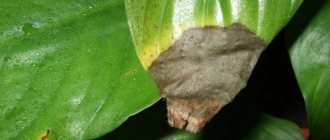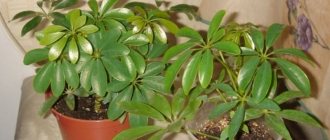Description and origin of Sansevieria
Sansevieria (or sansevieria) is a succulent from the Asparagus family. It is from a genus of stemless herbaceous evergreens and perennial plants. It is a distant relative of yucca and dracaena.
In the wild, Sansevieria is found in the subtropics and savannas; it loves dry and rocky soils. Distributed in Africa, southern regions of Asia and America, India and Madagascar. Among its many varieties are epiphytes (plants that live outside the soil).
This plant received its name in honor of Prince von Sansevierio from Naples, who lived in the 43rd century and did a lot for the development of natural sciences, and especially botany.
Sansevieria grows in the wild on dry soils
The color of Sansevieria leaves is dark green, sometimes brown. There are often varieties with a pattern in the form of stripes of white or yellow color. Sansevieria foliage is fleshy, it is collected in rosettes, sometimes has a silvery coating, like aloe or agave.
Typically, Sansevieria leaves are long and flat, but there are varieties with rounded, tubular or sword-shaped ones. As a rule, they grow vertically, although there are also plants that develop in a horizontal plane, spreading their leaves parallel to the ground.
Sansevieria does not always have erect leaves; there are also “spreading” types
The rate of development among varieties of this plant differs significantly. Usually, fast-growing sansevieria are bred at home, which are capable of forming up to 4 new leaves per year.
Sansevieria is one of the best air filters and oxygen producers. By absorbing harmful emissions, this flower produces an impressive amount of oxygen. This property is very valuable, especially for urban apartment buildings with central heating.
The tips of Sansevieria leaves are often pointed, and this peak should be protected. If it dries out or breaks off, the flower may slow down its growth or stop it altogether.
Sansevieria cylindrica has very plastic leaves, which allows you to give the bush an original shape
Another feature of sansevieria is that it can be used in different ways in the interior. For example, by planting a flower in a long and narrow pot or, on the contrary, in a short and round one, you will get fundamentally different and in their own whimsical green compositions. The plant looks great in containers of any shape. And Sansevieria cylindrica or robusta can be shaped, creating original silhouettes. Guide the leaves and secure them.
Sansevieria looks great in any pot
Varieties and varieties of plants
There are a lot of varieties of sansevieria, about two hundred. All of them can be divided into two groups according to the type of leaves: round and flat. The most common types:
- Sansevieria three-lane is well known. Its leaves are flat in cross-section, oval in shape, with a light pattern on a dark green field. It was this variety that was nicknamed pike tail and mother-in-law's tongue.
- A little less common in flower shops is Sansevieria three-striped Laurentii. Its difference is the bright yellow or light green edges of the leaves.
- A more compact type of sansevieria is called three-lane Laurentii Compacta. The plant has squat and wide leaves.
- Sansevieria three-lane Honey often appears on the shelves. This flower has short leaves that bend back, forming a beautiful spreading rosette. The color can be varied, from bright yellow to silver. There is Sansevieria Honey with curled leaves.
- Sansevieria cylindrica has erect green leaves that are round in cross section and have a pointed end. A very tall species of sansevieria, the length of its leaves reaches two meters.
- Sansevieria robusta has thick, tubular leaves. They grow in the shape of an ellipse, bending. The foliage color is pale green with “silvering” and a transverse pattern.
Photo gallery: three-strip sansevieria, compact and other types
Sansevieria robusta looks nothing like its relatives
Sansevieria cylindrica has round leaves in cross-section. Sansevieria three-lane Laurentii is distinguished by its yellow foliage color.
Sansevieria compact with shorter leaves
Sansevieria Honey bends the rosette back
Sansevieria three-stripe - the familiar pike tail
Video: how to care for “mother-in-law’s tongue” and what are the benefits of the plant
Planting/transplanting sansevieria: care at home
The long, sharp leaf-“tongue” of Sansevieria gave rise to comparison with a sarcastic mother-in-law, and its striped-green color with a pike’s tail.
Sansevieria itself , which naturally grows on the dry, rocky soils of the tropics of Africa, India and America, due to its hardiness and unpretentiousness, has a well-deserved reputation as an “unkillable” plant .
Even completely devoid of soil, just in a vessel with water, it persists for a long time and even grows.
However, the increased resistance of sansevieria is not a reason to deprive it of a convenient container and suitable soil.
Planting and replanting pike tail: optimal soil, suitable pot and other nuances
The soil for sansevieria needs to be light, capable of drying quickly and not accumulating moisture. It is better to choose low-nutrient soil, for example, for cacti or succulent crops. You need to independently prepare the land for planting sansevieria from leaf soil and sand, taking them in equal parts. It is advisable to sterilize the mixture before use. You can calcinate it in the oven, steam it in a water bath, or pour it with a weak (0.5 grams of powder per 1 liter) manganese solution, and then dry it.
The root system of Sansevieria is superficial
This plant is replanted as the pot fills with roots. Young Sansevierias usually change their pot once every 10 months, and older ones - at five years, when the flower becomes crowded.
The new container for the plant should be shallow, but its diameter should exceed the previous one by one and a half to two centimeters. Sansevieria has a superficial root system, so there is no point in using deep pots for it.
The transplanted flower should be fed only after 5–6 months.
Video: how to transplant sansevieria at home
Soil composition
For pike tail, it is better to choose moderately fertile, loose, slightly acidic .
From ready-made soils, a soil mixture for cacti and succulents , and for self-production - one of the following compositions:
- two parts of leaf soil, half of humus, one part of turf soil, peat and sand;
- one part turf, one part leaf soil, two parts coarse sand;
- three parts of turf land, one each of peat and sand.
You can also add perlite, vermiculite, brick chips, pieces of charcoal and a small amount of bone meal to the main types of soil for sansevieria.
Sometimes sansevieria is planted in compositions of ampelous and ground cover plants. In this case, so that the not too intensively growing “pike tail” can withstand competition with more aggressive species, a nutrient substrate of the following composition is suitable for it: three parts of turf soil and one part each of peat, coarse sand and compost.
You can find out more about what kind of land is needed for growing sansevieria at home and in open ground here.
Conditions for the flower
Sansevieria can easily tolerate low light, but it is not recommended to keep it in the far corner of the room all the time. In order for a flower to look beautiful, it needs light. For moderate sunbathing, he will respond with gratitude in the form of succulent leaves of bright colors. But Sansevieria does not like direct rays or long daylight hours.
As for the air temperature, the pike tail is even more unpretentious than with lighting. The flower calmly tolerates daily changes and sudden temperature changes.
Lighting for sansevieria should be moderate
Seasonal conditions: air temperature, humidity, lighting - table
| Condition | Autumn and winter | Spring and summer |
| Air temperature | You should stick to +14–16°C, higher temperatures are acceptable. But it should not fall below +10°C. | It is recommended to monitor the temperature increase, optimally not higher than +26°C. |
| Humidity level | Moderate. Sansevieria does not require spraying. | |
| Lighting | Bright and diffused light, partial shade is also suitable. Sansevieria can grow even in the shade. The best location is an east or west window. | Shade the plant in the middle of the day. |
Landing capacity
The root system of “mother-in-law’s tongue” develops slowly and is located shallowly.
Therefore, the container for planting should be chosen so that it is wide, but not deep , and matches the size of the plant.
Sansevieria will have difficulty mastering a planting capacity that is too large. Pots for mother-in-law's tongue are selected based on the following calculation: the height is half the diameter - for low varieties. For medium-sized and tall specimens, the height of the container can be equal to its diameter.
In addition, the bottom of the container must have drainage holes of sufficient size to ensure effective drainage of excess moisture.
The material of the optimal planting container is porous, allowing the evaporation of excess moisture and the breathing of roots. It is best to choose ceramics without a continuous glaze.
Many gardeners purchase sansevieria not only because of its aesthetic appeal, but also because of its simple care. However, pike tail is susceptible to diseases and pests. How to save the plant, as well as how and when mother-in-law’s tongue blooms and how the plant is propagated - we described in separate articles.
Plant care
Sansevieria is a plant that does not cause unnecessary trouble. Caring for the flower is simple, but you still need to take into account some features so that the pike tail turns cheerfully green.
Watering and fertilizing
Sansevieria is a succulent, so it can withstand prolonged drought without problems. Water it rarely, about once every 20 days, and little by little, only after the soil has completely dried. The main condition is that moisture should not get inside the outlet, otherwise the plant will rot and die.
Watering sansevieria should be limited in winter or simply when the temperature drops for a long period. If the plant is in a shaded area, also reduce the amount of water.
There is no need to spray this flower, but it is advisable to maintain leaf hygiene. Once a week, wipe them with a cloth soaked in plain water or brush off the dust with a soft brush.
Mineral fertilizers can be “long-lasting”; they are convenient for caring for perennial evergreens
From spring to autumn, sansevieria is fertilized twice a month, and in warm winters you can leave one fertilizing every 4 weeks. Products for succulents or mineral complexes for indoor plants are used as fertilizer. The dosage is always indicated on the package. It is not recommended to exceed the norm of fertilizing; it is better to even lower it a little.
For evergreen perennials that do not require frequent watering, it is very convenient to use bulk mineral fertilizers. They are embedded in the soil, and they dissolve gradually as the soil moistens. Such “long-lasting” fertilizers save time by supplying the plant with the necessary substances for up to three years.
Variegated plants are not fed with nitrogen-containing fertilizers, as they increase the production of chlorophyll. This provokes greening of the foliage and the pattern is lost.
Quiet time
The rest period of Sansevieria is unexpressed. In autumn and winter, the temperature should be lowered, but its fall should be controlled within the range of +14–16°C. It is better to completely eliminate fertilizing and limit watering.
Bloom
Sansevieria can bloom at home if it is provided with decent care. But the plant may not want to reproduce and refuse to flower. This is a small loss for the grower. Sansevieria flowers are not the most beautiful. They are pale, almost white, with long stamens and a strong and pleasant aroma. A tall peduncle throws out inflorescences collected in brushes.
Sansevieria blooms rarely, but it looks unusual
Video: how Sansevieria blooms
Is it necessary to form a crown?
There is no need to form a sansevieria bush. It is enough to carry out sanitary cleaning. Aged and damaged leaves can be removed once a year, this will allow the plant to look younger and neater. Such pruning does not negatively affect the growth rate of young leaves.
Common mistakes in care
Keeping Sansevieria at home does not cause any serious difficulties. This flower is very “accommodating” and does not create problems, but sometimes a situation may arise when the plant requires some attention.
Dark spots on sansevieria leaves are a sign of unscrupulous care
- Dark spots on the foliage. This disease manifests itself due to excessive waterlogging of the soil at low temperatures.
- Yellowing of leaves. This problem occurs when the flower does not have enough light or space in the pot.
- Softening of the sheet plate along its entire length, its transition to a horizontal position. Happens due to lack of light. The leaves begin to quickly stretch and, before they have time to develop, cannot support their weight.
- The tissues at the base of the leaf become soft and turn yellow. A similar sansevieria malaise occurs when irrigation water gets into the outlet. Tissue rotting and foliage dying occur.
- The ends darken and fade. The flower is freezing and signals this. This happens even with excess moisture and lack of light.
- Sansevieria leaves lose their elasticity and become flabby. The plant has not been watered for a long period.
Video: personal experience of growing compact sansevieria
If Sansevieria does not grow
The simplest reason why the mother-in-law's tongue stopped developing is the excessive crampedness of the potty. If a young plant has stopped growing, you should pay attention to the care conditions:
- improper watering;
- bright sunlight or shading;
- low temperatures;
- draft.
All these factors not only slow down development, but also become causes of Sansevieria disease. The plant itself will signal the problem.
Pike tongue has soft leaves
First, the plates begin to turn yellow, then soften at the base. The situation is caused by waterlogging of the soil. The only way to really save the situation is by transplanting it into a new pot. To do this, perform the following steps:
- the flower is carefully removed from the container;
- the roots are freed from the ground and inspected;
Note! If the root system has rotted, there is no point in resuscitating the entire plant.
- soft yellow leaves are removed.
Fresh soil is poured into a new container and the sprout is planted in it. The pot is placed away from the sun's rays and the watering regime is monitored.
Why do Sansevieria have limp leaves?
The opposite situation, when the soil is too dry, leads to lethargy of the plant (especially if the room temperature is below +15°). A quick way to bring Sansevieria to life is to move the pot to a warm place, remove the flaccid plates and water the soil.
Mother-in-law's drooping tongue
If signs of trunk rot are noticed, it is better to cut off the undamaged parts of the leaves and root them in a new container. Throw away the remains of the diseased plant.
Other developmental problems
Sansevieria, like cactus, does not like frequent watering. Excess moisture, as well as violation of other regimes, lead to serious deviations in the development of the pike tail.
How to fix sansevieria problems
| Sign | Cause | Recipe for resuscitation |
| Twisting | Leaves may curl due to lack of moisture | It is enough to establish regular, but not frequent watering, and the plant will stop curling |
| Rugosity | Affected by prolonged exposure to shade and lack of moisture. | The light regime is corrected by gradually moving the pot towards the window. After this, watering is adjusted |
| The leaves have fallen | Evidence that the plant is cold | It is enough to move the flower to a warm room, and the foliage will quickly straighten |
Knowing what sign indicates a problem, it is easier to understand why Sansevieria leaves curl (wither, turn yellow, etc.). This will allow you to provide first aid to the plant in time and establish proper care.
Diseases and pests
Sansevieria is a very hardy plant. It is not easy to provoke a disease in this flower, and even a child can take care of it. But, despite its good health, Sansevieria occasionally gets sick, and it does have enemies - thrips and spider mites.
Thrips appear when air temperatures rise. This happens in the middle of summer or in winter near heating devices if the room is poorly ventilated.
Thrips are small insects, up to one and a half millimeters in length, that live in small groups on both sides of leaves. They reproduce very quickly. Therefore, measures to combat this pest must be taken immediately after detection.
First of all, it is necessary to disinfect the pot, tray and place where the plant lived. All surfaces can be treated with any disinfectant that is used in everyday life. After this, you should wipe the leaves with a damp cloth soaked in a soap solution and spray the sansevieria with an insecticide, for example, Fitoverm or Actellik.
Thrips love hot rooms
If the leaves of the pike tail turn pale and small white spots appear on them, resembling a cobweb, this means that the plant is attacked by a spider mite.
Sansevieria should be washed and wiped well, and then treated with karbofos. The chemical should be used only in case of massive or repeated pest infestation of the plant, and in normal cases it is enough to wash it every three days, and the mites will die, since they do not tolerate moisture. When destroying a tick, try not to over-moisten the soil in the pot; during water procedures, cover it with film.
Spider mites do not reproduce at high air humidity
If the soil is waterlogged in winter, Sansevieria may begin to rot at the base. Leaves with this disease turn yellow and die. To avoid losing the plant, take immediate action. If the entire rosette is affected, cut off and root the healthy parts of the leaves and destroy the rhizome. If only part of the rosette is affected, remove the plant from the pot, remove the diseased organs, sprinkle the sections with sulfur and replant them in fresh soil. Keep warm and do not water for a while.
Landing
When planting a pike tail flower, you should definitely take care of good drainage: expanded clay, broken bricks with pieces of charcoal, or small pebbles should be placed on the bottom of the planting container and fill up to a third of its volume (young plants especially need a thick drainage layer).
Sansevieria should be planted together with a lump of earth entwined with roots, so that the not very powerful root system of the succulent is less damaged.
Sansevieria propagation
Pike tail propagates most often by vegetative methods: by dividing the bush and leaf cuttings.
Dividing the bush
- Cut the rhizome that connects the mother plant to the shoot with a sharp and clean knife.
- Dust the cut with ash or coal.
- Place the separated plant in a container with the prepared soil mixture.
- Water the shoot occasionally and do not feed it for a month.
Practice shows that divided sansevieria take root quite quickly and without problems.
Sansevieria can be propagated by leaf cuttings or dividing the rhizome
Leaf propagation
It is more difficult to propagate sansevieria by leaf cuttings. But this method is good because it can help you get several new plants at once.
- Leaves for cuttings should be selected that are mature and healthy. More often, they take the oldest leaves, cut them into pieces and dry them in the open air for up to two days.
- The cuttings are placed in a moist peat or sand substrate, buried by 2 cm.
- Cover the container with the cuttings with any non-breathable material that allows sunlight to pass through. Place in a warm and well-lit place, but without direct sunlight.
- The greenhouse is ventilated daily, and the substrate is moistened as it dries.
- In the third week, the cuttings will have roots, and after another month and a half - babies.
- The strengthened shoots can be planted already in the third month of development in a separate pot.
Variegated species of Sansevieria can lose color when cuttings from a leaf, so they should only be propagated by dividing the bush.
Video: pike tail from a leaf (master class)
What conditions must be provided for sansevieria to bloom?
One of my favorite indoor plants is Sansevieria
- a herbaceous stemless evergreen perennial with a thick creeping rhizome and long erect, usually striped, very dense leaves.
Other names for this plant: “pike tail”
,
“mother-in-law’s tongue”
. In Japan it is called “tiger tail”, in Brazil – “sword of San Jorge”, in the Netherlands – “women’s tongue”, in Germany – “African hemp”, in France – “snake plant”.
I appreciate this plant for its amazing endurance, unpretentiousness and wonderful decorative appearance. Sansevieria requires minimal care and is highly resistant to diseases and pests - only very weakened plants are affected by spider mites and scale insects. One day I was making tea and accidentally scalded the leaves of a sansevieria growing in our kitchen with hot steam. Of course, I was very upset. But, to my surprise and great joy, the plant was not damaged at all - the steam from the boiling kettle did not leave a burn or even the slightest trace on the leaves!
In some countries, for example, in Brazil, Portugal, and African countries, the indigenous population uses this plant as protection from evil, the evil eye and various obsessions (for this, sansevieria is usually placed at the entrance to the house). In addition, leaf fibers were previously used to make bow strings and ropes. And now sansevieria is cultivated in some areas as a valuable industrial crop (for fiber production).
NASA research has shown that Sansevieria is one of the best plants that effectively purifies indoor air and improves its quality. Sansevieria removes harmful substances released from new furniture, various building materials, synthetic home furnishings, etc. The plant absorbs toxins such as nitrogen oxides, formaldehyde and benzene, removes carbon dioxide, and actively releases oxygen at night. Since Sansevieria is a natural air purifier, it is recommended to place it in the bedroom and kitchen.
At the same time, some Portuguese researchers consider the plant juice to be toxic. Poisoning occurs when the juice enters the bloodstream and when it is swallowed in large quantities, in these cases the following symptoms are possible: abdominal pain, vomiting, diarrhea, which disappear after some time. Since, fortunately, I have not had to deal with these negative manifestations, I prefer to consider the plant only as an amazing gift for a novice gardener.
Sansevieria as a potted plant is an excellent option for decorating your home and office. Leaves are used cut to create various compositions. After the cut leaves of the composition standing in water have roots, they can be planted in the soil substrate.
Distribution of Sansevieria
Under natural conditions, plants of the genus Sansevieria grow in areas with dry tropical and subtropical climates - Africa, Asia, Central and South America, Australia, forming dense thickets. Stiff leaves grow vertically from a rosette; a creeping underground rhizome sometimes reaches the soil surface. In nature, Sansevieria grows well in sandy soil, soil with gravel, for example, in deserts, semi-deserts and savannas.
Description of the plant
Plants of the genus Sansevieria usually have dense, long, erect, gathered in a basal rosette, green, dark green or silvery leaves with various decorative colored stripes (transverse or longitudinal). Depending on the variety, the stripes on the leaves of sansevieria can be white, light gray, light gray-green, silver-white, bright yellow, yellow, golden, etc.
The height of the plant, depending on the variety, is 12-150 cm - there are low-growing, medium-growing and tall varieties, leaf width is 5-9 cm.
As a rule, flowering sansevierias are quite large specimens. Their flowers are small, greenish-white (or white-pink, some have a pearlescent tint), with narrow curling petals and long stamens, inconspicuous, but very fragrant (their aroma is delicate and pleasant, usually intensifies in the evening), producing nectar, collected in an inflorescence raceme. A flower arrow 15-20 cm long, emerging from the center of the rosette, appears between the leaves. Flowering does not last long, after which the wilted arrow needs to be removed.
It should be noted that Sansevieria blooms infrequently and irregularly and only under favorable conditions. I have not yet been able to trace its seasonal pattern.
